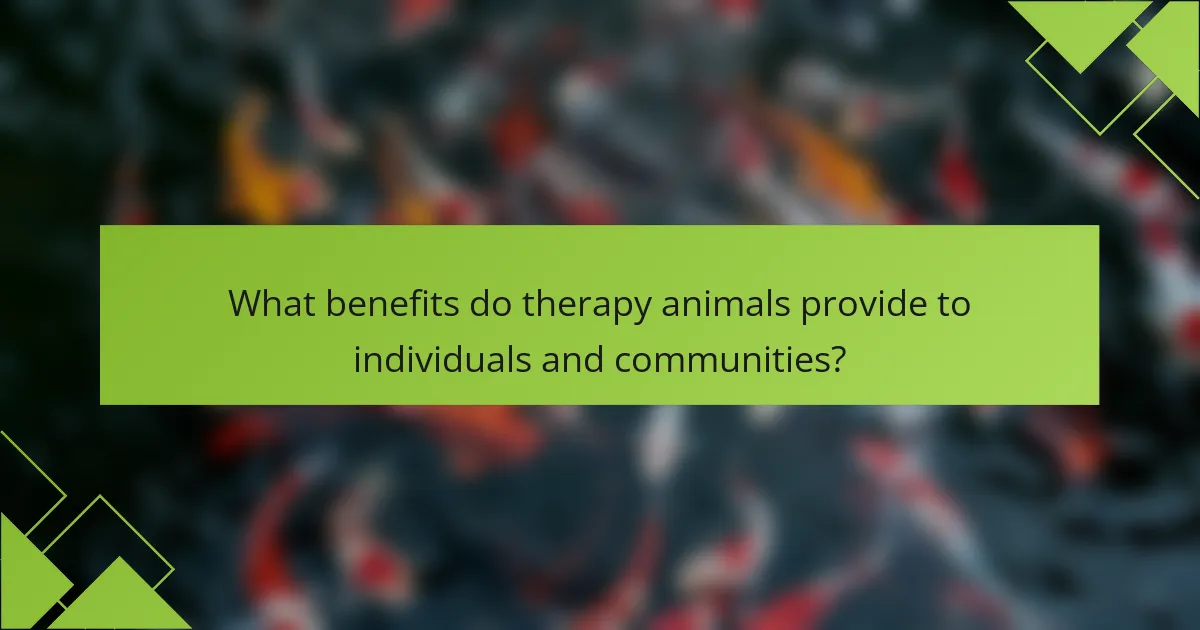Training therapy animals enhances emotional support and mental well-being. This process involves specific requirements, effective techniques, and the numerous benefits these animals provide. Key aspects include obedience training, socialization, and regular health check-ups. Understanding the differences between therapy and service animals is crucial for effective training and implementation.

What are the essential requirements for training therapy animals?
Training therapy animals requires specific skills, socialization, and health standards. Essential requirements include basic obedience training, exposure to various environments, and a calm temperament. Regular health check-ups ensure the animal is fit for interaction. Certification programs often provide structured training guidelines.
Which certifications are recognized for therapy animal training?
Certifications recognized for therapy animal training include those from organizations like the International Association of Animal Behavior Consultants and Pet Partners. These certifications ensure animals meet specific training and behavioural standards. Additionally, the American Kennel Club offers the Canine Good Citizen program, which is often a prerequisite for therapy dog training. These certifications validate the skills and temperament of therapy animals, enhancing their effectiveness in therapeutic settings.
What are the minimum age and health standards for therapy animals?
Therapy animals must typically be at least one year old and meet specific health standards to ensure safety and effectiveness. Minimum age requirements ensure that the animals have reached maturity and can handle various environments. Health standards generally include vaccinations, regular veterinary check-ups, and a clean bill of health to prevent the spread of diseases. These criteria help maintain the well-being of both the therapy animals and the individuals they assist.
How do training environments differ across regions?
Training environments for therapy animals vary significantly across regions due to cultural attitudes and regulations. In urban areas, facilities often emphasize socialization and exposure to diverse stimuli, while rural settings may focus more on natural environments and practical training scenarios.
Different regions may also have unique training techniques influenced by local needs. For instance, therapy animal training in healthcare settings might prioritize interactions with patients, while in educational contexts, the focus may shift to supporting children’s emotional well-being.
Regulations governing therapy animal training can differ, impacting the requirements for certification and the skills emphasized during training. Some regions may have stricter guidelines, ensuring a standardized approach, while others may allow for more flexibility and creativity in training methods.
Overall, understanding these regional differences is crucial for developing effective training programs tailored to specific environments and community needs.
What role do handlers play in therapy animal training?
Handlers play a crucial role in therapy animal training by ensuring effective communication and support between the animal and clients. They are responsible for teaching the animal commands, reinforcing positive behaviours, and facilitating interactions during therapy sessions. Handlers must understand the unique needs of both the animal and the individuals they assist, creating a safe and nurturing environment. This relationship enhances the therapeutic benefits, as a well-trained therapy animal can respond effectively to emotional cues, fostering comfort and healing.

What techniques are most effective in training therapy animals?
Positive reinforcement techniques are most effective in training therapy animals. These methods encourage desired behaviours through rewards, fostering a strong bond between the animal and trainer. Consistency in commands and gentle socialization are also crucial.
Training can include desensitization to various environments, ensuring animals remain calm and responsive in diverse situations. Regular practice sessions, clear communication, and patience enhance the learning process. Building trust and using play as a reward can further improve training outcomes.
How does positive reinforcement enhance therapy animal training?
Positive reinforcement significantly enhances therapy animal training by encouraging desired behaviours through rewards. This method fosters a positive learning environment, making animals more eager to participate. For example, using treats or praise can effectively teach commands and social behaviours. Research shows that animals trained with positive reinforcement exhibit higher retention rates and increased motivation compared to those trained with aversive methods. This approach not only strengthens the bond between the animal and trainer but also promotes a more enjoyable training experience for both parties.
What specific skills should therapy animals learn?
Therapy animals should learn specific skills such as obedience, socialization, and comfort provision. These skills ensure they can effectively assist individuals in therapeutic settings.
1. Obedience: Animals must respond reliably to commands to ensure safety and control.
2. Socialization: They should be comfortable around various people and environments to foster positive interactions.
3. Comfort Provision: Animals need to provide emotional support, often through gentle behaviour and physical closeness.
4. Desensitization: Exposure to different sounds and situations helps them remain calm in diverse settings.
5. Tolerance: Therapy animals should tolerate handling and interactions without stress.
6. Focus: They must maintain attention on their handler, especially in busy environments.
Which training methods are preferred in different countries?
Training methods for therapy animals vary by country, influenced by cultural practices and regulations. In the United States, positive reinforcement techniques are predominant, focusing on reward-based training. In Germany, structured programs emphasize obedience and socialization, often requiring certifications. The UK favours a blend of reward and clicker training, promoting humane methods. In Japan, therapy animal training incorporates traditional values, emphasizing calmness and social interaction. Australia prioritizes hands-on training with real-life scenarios, ensuring animals are well-prepared for therapy settings. Each country’s approach reflects unique cultural attitudes towards animal welfare and therapy practices.
How can socialization impact therapy animal effectiveness?
Socialization significantly enhances the effectiveness of therapy animals by improving their interactions with clients. Well-socialized animals exhibit calmness and adaptability in various environments, which fosters trust and comfort in therapy sessions. Additionally, socialization helps therapy animals respond appropriately to diverse stimuli, making them more effective in supporting emotional and psychological healing. Training that includes socialization techniques can lead to better client outcomes and increased satisfaction with therapy services.

What benefits do therapy animals provide to individuals and communities?
Therapy animals provide emotional support, improve mental health, and foster social connections. They help reduce anxiety, depression, and stress, enhancing overall well-being. Therapy animals can also assist in physical rehabilitation, encouraging movement and engagement. Their presence promotes community bonding and creates inclusive environments.
How do therapy animals improve mental health outcomes?
Therapy animals significantly improve mental health outcomes by providing emotional support and companionship. They help reduce anxiety, depression, and stress levels. Training requirements for therapy animals include socialization, basic obedience, and specific behaviour techniques. Benefits include enhanced emotional well-being, increased social interaction, and improved coping skills for individuals facing mental health challenges.
What physical health benefits can therapy animals offer?
Therapy animals offer numerous physical health benefits, including reduced stress, lower blood pressure, and improved mobility. They provide companionship, which can lead to enhanced emotional well-being, indirectly benefiting physical health. Studies show that interaction with therapy animals can decrease anxiety and pain levels, promoting faster recovery in patients. Additionally, therapy animals encourage physical activity, such as walking or playing, which contributes to overall fitness and health.
How do therapy animals contribute to educational settings?
Therapy animals enhance educational settings by providing emotional support, improving social skills, and reducing anxiety. Their presence fosters a positive learning environment, encouraging student engagement and participation.
Training for therapy animals involves meeting specific requirements, such as temperament assessment and socialization techniques. These animals typically undergo training to respond to various stimuli and interact positively with students. Benefits include increased motivation and improved mental health, leading to better academic performance.
Research shows that students who interact with therapy animals experience lower stress levels and enhanced focus. This unique attribute of therapy animals makes them valuable assets in educational environments.

What unique attributes set therapy animals apart from service animals?
Therapy animals differ from service animals primarily in their training and purpose. Therapy animals provide comfort and support in various settings, while service animals are trained to perform specific tasks for individuals with disabilities.
Therapy animals undergo training focused on social interaction and emotional support rather than task-specific skills. They often work in hospitals, schools, and nursing homes, promoting mental well-being. In contrast, service animals receive specialized training to assist individuals with specific needs, such as guiding the visually impaired or alerting to medical conditions.
The unique attribute of therapy animals is their role in enhancing emotional health, which is not a requirement for service animals. This distinction highlights the varying purposes and training methods for each type of animal.
How do therapy animal roles differ from emotional support animals?
Therapy animals undergo specialized training to perform specific tasks, while emotional support animals provide comfort without formal training. Therapy animals assist in therapeutic settings, often working with professionals. Emotional support animals primarily offer companionship and emotional relief to their owners. The training requirements for therapy animals are more rigorous, focusing on obedience and task-specific skills. In contrast, emotional support animals require less formal training but must be well-behaved.
What types of animals can be trained as therapy animals?
Many types of animals can be trained as therapy animals, including dogs, cats, rabbits, and even miniature horses. Dogs are the most common due to their trainability and social nature. Cats can provide comfort and companionship, while rabbits and miniature horses are also effective in therapeutic settings. Each species brings unique attributes that enhance the therapy experience. For instance, dogs often engage in active play, while cats may offer calming presence.

What challenges do trainers face in therapy animal training?
Trainers face numerous challenges in therapy animal training, including behavioural issues, environmental distractions, and inconsistent training methods. Behavioural problems can hinder an animal’s ability to perform effectively in therapeutic settings. Environmental distractions, such as noise or unfamiliar people, may disrupt training sessions. Additionally, trainers often encounter varying levels of commitment and understanding among animal handlers, complicating the training process. These challenges require trainers to adapt techniques and maintain patience to ensure successful outcomes.
How can trainers manage behavioural issues during training?
Trainers can manage behavioural issues during training by implementing consistent techniques and strategies. Establishing clear rules and boundaries helps animals understand expectations. Positive reinforcement encourages desired behaviours, while redirecting unwanted behaviours minimizes distractions. Regular assessments of progress allow trainers to adjust techniques as needed. Engaging in socialization activities also supports behavioural development, making training sessions more effective.
What are common misconceptions about therapy animals?
Many believe therapy animals are simply pets providing comfort, but they undergo specific training. Common misconceptions include the idea that any animal can be a therapy animal, that training is minimal, and that their role is solely for emotional support. In reality, therapy animals must meet rigorous training requirements and often work under the guidance of professionals. This training ensures they can perform tasks that aid individuals with various emotional and physical challenges.

What are best practices for ensuring the success of therapy animal programs?
To ensure the success of therapy animal programs, focus on comprehensive training, clear communication, and ongoing evaluation. Training should include socialization, obedience, and specific task performance tailored to therapeutic settings. Regular assessments and feedback from handlers enhance program effectiveness. Collaboration with mental health professionals ensures alignment with therapeutic goals.
What strategies can enhance the bond between therapy animals and clients?
Enhancing the bond between therapy animals and clients requires consistent training, socialization, and positive reinforcement techniques. Building trust through regular interactions fosters emotional connections.
Effective strategies include exposing therapy animals to various environments to reduce anxiety and increase adaptability. Additionally, using play and rewards during sessions can strengthen the relationship.
Regular assessments of the animal’s behaviour and client feedback are crucial for tailoring approaches to individual needs. This ensures both parties feel comfortable and valued throughout their interactions.
Implementing these strategies promotes a supportive atmosphere, enhancing the therapeutic experience for clients and maximizing the benefits of animal-assisted therapy.
How can ongoing training and assessment improve therapy animal effectiveness?
Ongoing training and assessment enhance therapy animal effectiveness by ensuring they remain responsive and adaptable. Regular training updates skills, reinforces positive behaviour, and fosters stronger bonds with handlers. Assessment identifies areas for improvement, ensuring animals meet evolving therapeutic needs. Continuous education also promotes safety and compliance with industry standards, ultimately improving client outcomes.
